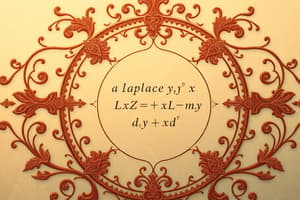Podcast
Questions and Answers
Which of the following best describes the function of an astrolabe?
Which of the following best describes the function of an astrolabe?
- A system where land and enslaved people were granted to reward conquerors.
- A device using a magnetic pointer to show direction.
- A tool used to determine the position of celestial objects. (correct)
- A small, maneuverable sailing ship.
What economic goal was at the core of mercantilism?
What economic goal was at the core of mercantilism?
- Increasing a country's wealth and power by controlling trade and people. (correct)
- Promoting the economic independence of colonies.
- Distributing wealth equally among nations.
- Facilitating free trade between countries without governmental oversight.
How did joint-stock companies facilitate exploration and colonization?
How did joint-stock companies facilitate exploration and colonization?
- By offering free land to anyone willing to settle in new territories.
- By pooling financial resources of investors, reducing individual risk. (correct)
- By providing military training to explorers.
- By ensuring that colonies were governed independently of their home country.
What distinguished a caravel from other ships of its time, making it optimal for exploration?
What distinguished a caravel from other ships of its time, making it optimal for exploration?
What labor agreement defines an indentured servant's obligations?
What labor agreement defines an indentured servant's obligations?
Which action best exemplifies the meaning of 'circumnavigate'?
Which action best exemplifies the meaning of 'circumnavigate'?
How did the encomienda system benefit the Spanish conquistadors?
How did the encomienda system benefit the Spanish conquistadors?
What is considered chattel?
What is considered chattel?
In the context of the Age of Exploration, what does 'cost-effective' primarily suggest regarding expeditions?
In the context of the Age of Exploration, what does 'cost-effective' primarily suggest regarding expeditions?
Why is understanding 'cultivation' important when studying the Age of Exploration and Colonization?
Why is understanding 'cultivation' important when studying the Age of Exploration and Colonization?
Flashcards
Mission
Mission
A settlement built for the purpose of converting Native Americans to Christianity and expanding territory.
Mutiny
Mutiny
To rebel against leaders, especially on a ship.
Navigation
Navigation
The skill or science of determining the route to a destination.
Overseer
Overseer
Signup and view all the flashcards
Plantation
Plantation
Signup and view all the flashcards
Astrolabe
Astrolabe
Signup and view all the flashcards
Caravel
Caravel
Signup and view all the flashcards
Cargo
Cargo
Signup and view all the flashcards
Chattel
Chattel
Signup and view all the flashcards
Circumnavigate
Circumnavigate
Signup and view all the flashcards
Study Notes
Second-Order Linear PDEs
- A general form is described as $Au_{xx} + 2Bu_{xy} + Cu_{yy} + Du_x + Eu_y + Fu = G$, where A through G are functions of $(x, y)$.
- If $B^2 - AC < 0$, the PDE is Elliptic, like Laplace's equation $\nabla^2 u = 0$.
- If $B^2 - AC = 0$, the PDE is Parabolic, like the Heat equation $u_t = \nabla^2 u$.
- If $B^2 - AC > 0$, the PDE is Hyperbolic, like the Wave equation $u_{tt} = \nabla^2 u$.
Examples
- Laplace Equation is shown as:
- $\nabla^2 u = 0$
- In 2D Cartesian coordinates: $\frac{\partial^2 u}{\partial x^2} + \frac{\partial^2 u}{\partial y^2} = 0$
- In 2D Polar coordinates: $\frac{1}{r} \frac{\partial}{\partial r} \left( r \frac{\partial u}{\partial r} \right) + \frac{1}{r^2} \frac{\partial^2 u}{\partial \theta^2} = 0$
- Heat Equation is shown as:
- $\frac{\partial u}{\partial t} = \alpha \nabla^2 u$
- In 1D: $\frac{\partial u}{\partial t} = \alpha \frac{\partial^2 u}{\partial x^2}$
- Wave Equation is shown as:
- $\frac{\partial^2 u}{\partial t^2} = c^2 \nabla^2 u$
- In 1D: $\frac{\partial^2 u}{\partial t^2} = c^2 \frac{\partial^2 u}{\partial x^2}$
Solving PDEs
- Separation of Variables is shown as:
- Assume a solution of the form $u(x, t) = X(x)T(t)$.
- Substitute into the PDE and separate variables.
- Solve the resulting ODEs for $X(x)$ and $T(t)$.
- Apply boundary conditions to determine constants.
- Superimpose solutions to satisfy initial conditions, if needed.
Example: Heat Equation
- Consider the heat equation with Dirichlet boundary conditions:
- $\frac{\partial u}{\partial t} = \alpha \frac{\partial^2 u}{\partial x^2}$, $0 < x < L$, $t > 0$
- $u(0, t) = u(L, t) = 0$
- $u(x, 0) = f(x)$
- Let $u(x, t) = X(x)T(t)$.
- The process is shown as:
- $X(x)T'(t) = \alpha X''(x)T(t)$
- $\frac{T'(t)}{\alpha T(t)} = \frac{X''(x)}{X(x)} = -\lambda$
- $T'(t) + \alpha \lambda T(t) = 0$
- $X''(x) + \lambda X(x) = 0$
- The process is shown as:
- Solving for $X(x)$:
- $X(x) = A \cos(\sqrt{\lambda}x) + B \sin(\sqrt{\lambda}x)$
- Applying boundary conditions:
- $X(0) = X(L) = 0$
- $X(0) = A = 0$
- $X(L) = B \sin(\sqrt{\lambda}L) = 0$
- $\sqrt{\lambda}L = n\pi$, $n = 1, 2, 3,...$
- $\lambda_n = \left( \frac{n\pi}{L} \right)^2$
- $X_n(x) = B_n \sin\left( \frac{n\pi x}{L} \right)$
- Solving for $T(t)$:
- $T'(t) + \alpha \left( \frac{n\pi}{L} \right)^2 T(t) = 0$
- $T_n(t) = C_n e^{-\alpha \left( \frac{n\pi}{L} \right)^2 t}$
- General solution:
- $u(x, t) = \sum_{n=1}^{\infty} D_n \sin\left( \frac{n\pi x}{L} \right) e^{-\alpha \left( \frac{n\pi}{L} \right)^2 t}$
- Applying initial condition:
- $u(x, 0) = f(x) = \sum_{n=1}^{\infty} D_n \sin\left( \frac{n\pi x}{L} \right)$
- $D_n = \frac{2}{L} \int_0^L f(x) \sin\left( \frac{n\pi x}{L} \right) dx$
Studying That Suits You
Use AI to generate personalized quizzes and flashcards to suit your learning preferences.





